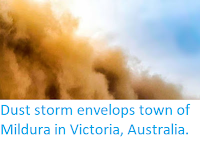Six people have now been confirmed dead as Australia suffers its worst bushfires in decades. All six fatalities occurred in New South Wales, where more than 600 homes have been destroyed and dozens of people have been treated for smoke inhalation. An area of about 16 500 km³ has been burned within the state, with one fire front reaching about 6000 km in length. In Queensland an area of about 1800 km³ has been raised and 20 homes destroyed, while in South Australia around 50 km³ has burned and at least 33 people injured.
A wildfire raging in New South Wales this week. Peter Parks/AFP/Getty Images.
Wildfires are an annual event in Australia, particularly during the annual dry season that lasts from May to October, but this year's fires have been exceptionally severe, driven by high temperatures in the Australian interior and high seasonal winds. The country has suffered exceptional fire seasons in the past, most recently in 1984 and 1974, both of which saw far more extensive fires than this year, but this year's fires have extended far further from the country's interior, reaching into more populated areas closer to the coast, a pattern that has been seen increasingly in recent years, and which is widely considered to by a symptom of a changing climate associated with global warming.
A wildfire in New South Wales on 15 November 2019. Brett Hemmings/Getty Images.
The wildfire ecology of Australia is driven by the presence of large numbers of Eucalyptus, or Gum Trees, fast growing members of the Myrtle Family,
Myrtaceae, which are native to Australia but now grown extensively for their
timber in many other parts of the world. They are valued for their fast
growth, enabling them to produce much timber quickly, However they
dominate ecosystems in which they become established, causing a variety
of problems both for native plants and animals, as Human residents. The
trees produce large amounts of volatile terpanoids which suppress the
growth of other plants, and consume large amounts of water, lowering the
water table in areas where they become established. The trees also shed
branches regularly, as well as leaves and strips of bark, creating a
dry environment littered with dry plant material where wildfires quickly
become established. The terpinoids in the wood of Eucalyptus cause
these forests to burn readily, typically at a temperature about 30 °C
higher than other forest fires, which can kill specie such as Oak, which
can often survive fires. This increases the ecological dominance of the
Eucalyptus, as, while the trees are killed by the fires, the seed pods
can survive and rapidly germinate after fires, which since the trees
grow quickly, enables them to quickly claim the newly available land.
See also...
Follow Sciency Thoughts on Facebook.








